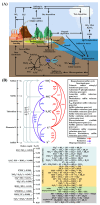Electron Transfer in the Biogeochemical Sulfur Cycle
- PMID: 38792612
- PMCID: PMC11123123
- DOI: 10.3390/life14050591
Electron Transfer in the Biogeochemical Sulfur Cycle
Abstract
Microorganisms are key players in the global biogeochemical sulfur cycle. Among them, some have garnered particular attention due to their electrical activity and ability to perform extracellular electron transfer. A growing body of research has highlighted their extensive phylogenetic and metabolic diversity, revealing their crucial roles in ecological processes. In this review, we delve into the electron transfer process between sulfate-reducing bacteria and anaerobic alkane-oxidizing archaea, which facilitates growth within syntrophic communities. Furthermore, we review the phenomenon of long-distance electron transfer and potential extracellular electron transfer in multicellular filamentous sulfur-oxidizing bacteria. These bacteria, with their vast application prospects and ecological significance, play a pivotal role in various ecological processes. Subsequently, we discuss the important role of the pili/cytochrome for electron transfer and presented cutting-edge approaches for exploring and studying electroactive microorganisms. This review provides a comprehensive overview of electroactive microorganisms participating in the biogeochemical sulfur cycle. By examining their electron transfer mechanisms, and the potential ecological and applied implications, we offer novel insights into microbial sulfur metabolism, thereby advancing applications in the development of sustainable bioelectronics materials and bioremediation technologies.
Keywords: biogeochemical sulfur cycle; cytochrome; electroactive microorganisms; electron transfer; long-distance electron transfer; pili.
Conflict of interest statement
The authors declare no conflicts of interest.
Figures





Similar articles
-
Microbial communities related to the sulfur cycle in the Sansha Yongle Blue Hole.Microbiol Spectr. 2023 Aug 25;11(5):e0114923. doi: 10.1128/spectrum.01149-23. Online ahead of print. Microbiol Spectr. 2023. PMID: 37623326 Free PMC article.
-
Molecular underpinnings for microbial extracellular electron transfer during biogeochemical cycling of earth elements.Sci China Life Sci. 2019 Oct;62(10):1275-1286. doi: 10.1007/s11427-018-9464-3. Epub 2019 Mar 12. Sci China Life Sci. 2019. PMID: 30900163 Review.
-
Perspectives on Microbial Electron Transfer Networks for Environmental Biotechnology.Front Microbiol. 2022 Apr 12;13:845796. doi: 10.3389/fmicb.2022.845796. eCollection 2022. Front Microbiol. 2022. PMID: 35495710 Free PMC article.
-
Ecological Role of Bacteria Involved in the Biogeochemical Cycles of Mangroves Based on Functional Genes Detected through GeoChip 5.0.mSphere. 2022 Feb 23;7(1):e0093621. doi: 10.1128/msphere.00936-21. Epub 2022 Jan 12. mSphere. 2022. PMID: 35019668 Free PMC article.
-
Electromicrobiology: the ecophysiology of phylogenetically diverse electroactive microorganisms.Nat Rev Microbiol. 2022 Jan;20(1):5-19. doi: 10.1038/s41579-021-00597-6. Epub 2021 Jul 27. Nat Rev Microbiol. 2022. PMID: 34316046 Review.
Cited by
-
Effects of bio-nano-selenium on wheat grain morphology, selenium transport enrichment and antioxidant enzyme activities.Front Plant Sci. 2025 Mar 5;16:1516005. doi: 10.3389/fpls.2025.1516005. eCollection 2025. Front Plant Sci. 2025. PMID: 40110351 Free PMC article.
-
Bioremediation of non-point hydrogen sulfide emissions using bacterial cellulose/activated carbon membrane.Microb Cell Fact. 2025 Mar 12;24(1):63. doi: 10.1186/s12934-025-02686-0. Microb Cell Fact. 2025. PMID: 40069874 Free PMC article.
-
Advancements in enzymatic reaction-mediated microbial transformation.Heliyon. 2024 Sep 20;10(19):e38187. doi: 10.1016/j.heliyon.2024.e38187. eCollection 2024 Oct 15. Heliyon. 2024. PMID: 39430465 Free PMC article. Review.
-
Independently evolved extracellular electron transfer pathways in ecologically diverse Desulfobacterota.ISME J. 2025 Jan 2;19(1):wraf097. doi: 10.1093/ismejo/wraf097. ISME J. 2025. PMID: 40381216 Free PMC article.
-
Livestock Slurry and Sustainable Pasture Management: Microbial Roles, Environmental Impacts, and Regulatory Perspectives in Ireland and Europe.Microorganisms. 2025 Mar 29;13(4):788. doi: 10.3390/microorganisms13040788. Microorganisms. 2025. PMID: 40284625 Free PMC article. Review.
References
-
- Brimblecombe P. Treatise on Geochemistry: Second Edition. Elsevier Inc.; Amsterdam, The Netherlands: 2013. The global sulfur cycle; pp. 559–591.
-
- Li Y., Yu S., Strong J., Wang H. Are the biogeochemical cycles of carbon, nitrogen, sulfur, and phosphorus driven by the “FeIII–FeII redox wheel” in dynamic redox environments? J. Soils Sediments. 2012;12:683–693. doi: 10.1007/s11368-012-0507-z. - DOI
-
- Sievert S.M., Kiene R.P., Schulz-Vogt H.N. The sulfur cycle. Oceanography. 2007;20:117–123. doi: 10.5670/oceanog.2007.55. - DOI
Publication types
Grants and funding
LinkOut - more resources
Full Text Sources

